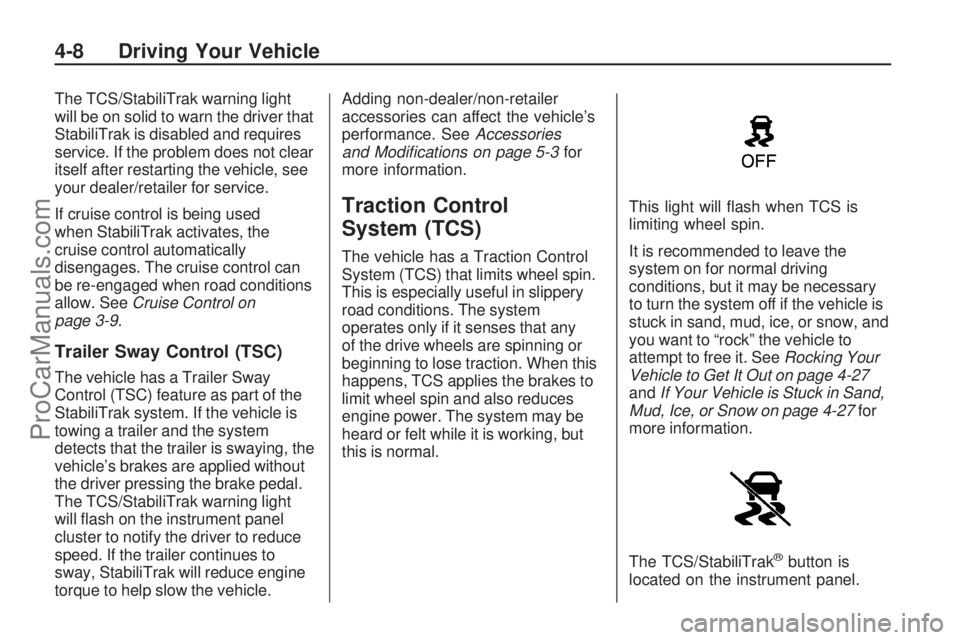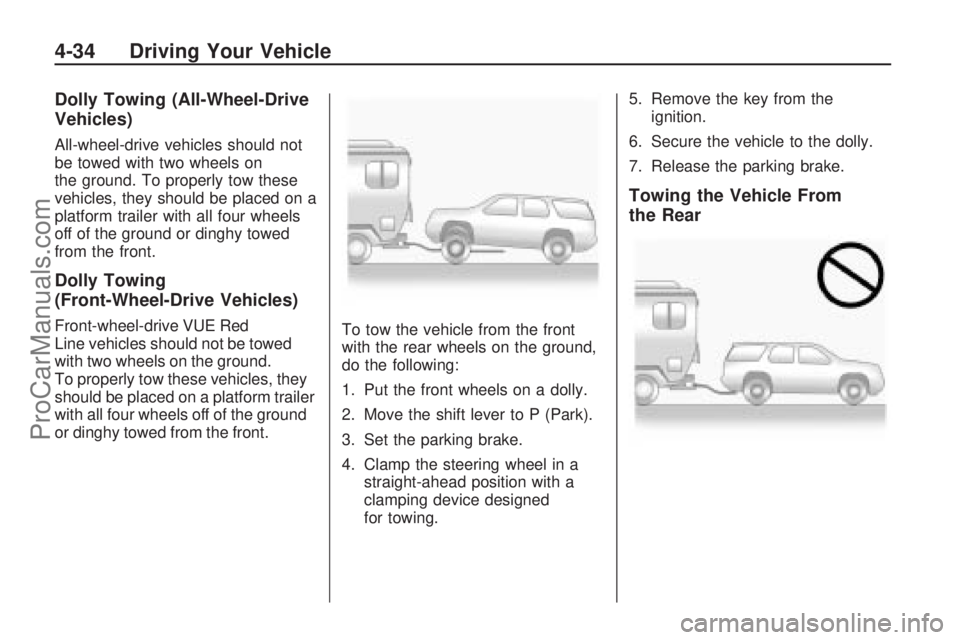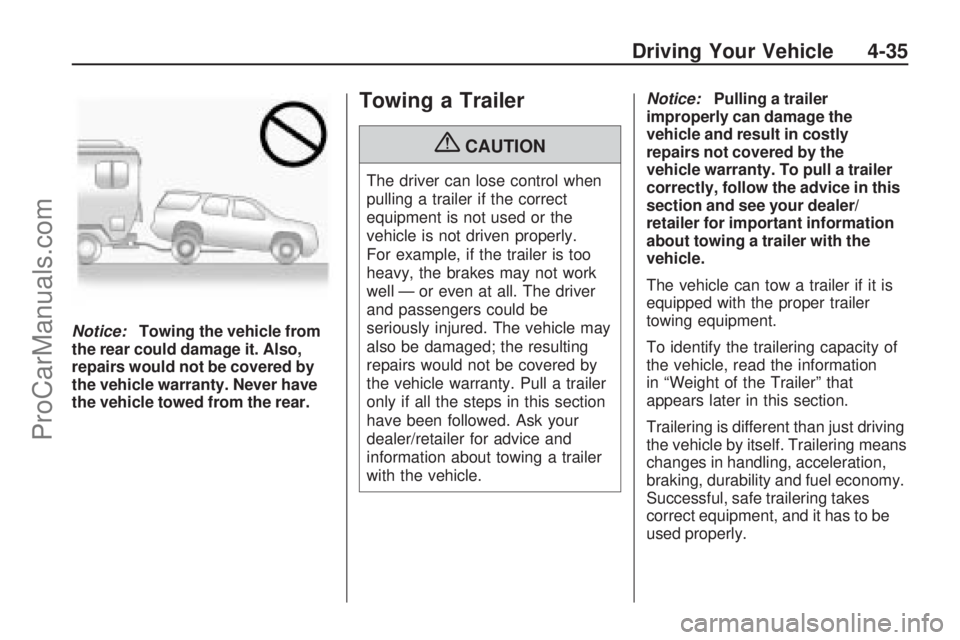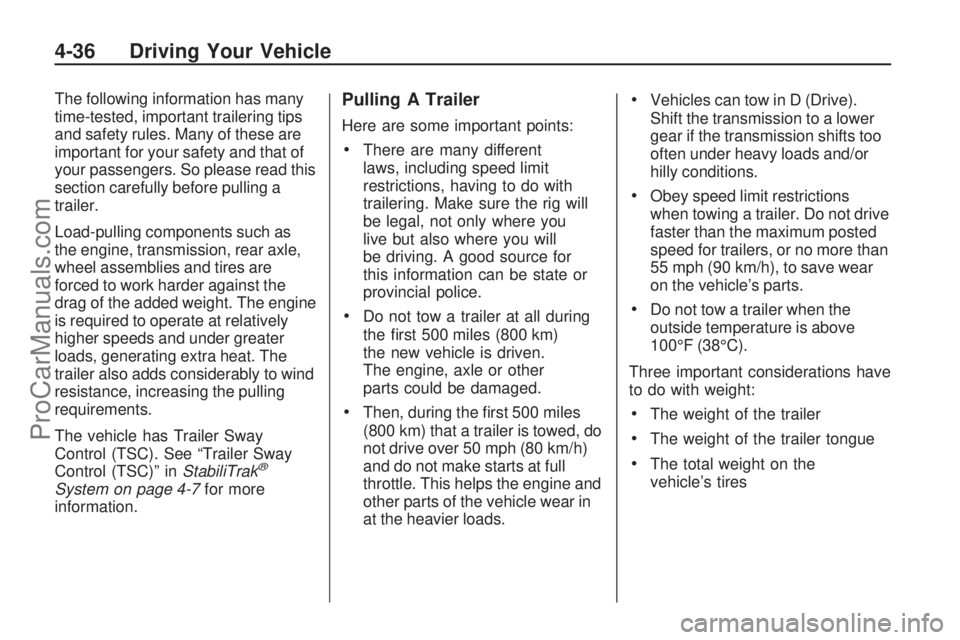towing SATURN VUE 2009 User Guide
[x] Cancel search | Manufacturer: SATURN, Model Year: 2009, Model line: VUE, Model: SATURN VUE 2009Pages: 386, PDF Size: 2.3 MB
Page 205 of 386

Driving Your
Vehicle
Your Driving, the Road,
and the Vehicle
Driving Your Vehicle..............4-1
Driver Behavior.....................4-2
Driving Environment...............4-2
Vehicle Design......................4-2
Driving for Better Fuel
Economy............................4-3
Defensive Driving..................4-3
Drunk Driving.......................4-4
Control of a Vehicle...............4-4
Braking................................4-5
Antilock Brake
System (ABS).....................4-6
Braking in Emergencies..........4-6
StabiliTrak
®System...............4-7
Traction Control
System (TCS).....................4-8
All-Wheel Drive (AWD)
System..............................4-9
Steering...............................4-9Off-Road Recovery..............4-11
Passing..............................4-11
Loss of Control...................4-12
Off-Road Driving..................4-13
Driving at Night...................4-22
Driving in Rain and
on Wet Roads...................4-23
Before Leaving on
a Long Trip.......................4-24
Highway Hypnosis...............4-24
Hill and Mountain Roads......4-24
Winter Driving.....................4-25
If Your Vehicle is Stuck in
Sand, Mud, Ice, or Snow......4-27
Rocking Your Vehicle
toGetItOut.....................4-27
Loading the Vehicle.............4-28
TowingTowing Your Vehicle............4-32
Recreational Vehicle Towing. . .4-32
Towing a Trailer..................4-35
Your Driving, the
Road, and the Vehicle
Driving Your Vehicle
Whenever we drive, we are taking
on an important responsibility.
This is true for any motor
vehicle — passenger car, van,
truck, sport utility. Driver behavior,
the driving environment, and the
vehicle’s design all affect how well a
vehicle performs. But statistics show
that the most important factor, by far,
is how we drive.
Knowing how these three factors
work together can help you
understand how your vehicle
handles and what you can do to
avoid many types of crashes,
including a rollover crash.
Driving Your Vehicle 4-1
ProCarManuals.com
Page 212 of 386

The TCS/StabiliTrak warning light
will be on solid to warn the driver that
StabiliTrak is disabled and requires
service. If the problem does not clear
itself after restarting the vehicle, see
your dealer/retailer for service.
If cruise control is being used
when StabiliTrak activates, the
cruise control automatically
disengages. The cruise control can
be re-engaged when road conditions
allow. SeeCruise Control on
page 3-9.
Trailer Sway Control (TSC)
The vehicle has a Trailer Sway
Control (TSC) feature as part of the
StabiliTrak system. If the vehicle is
towing a trailer and the system
detects that the trailer is swaying, the
vehicle’s brakes are applied without
the driver pressing the brake pedal.
The TCS/StabiliTrak warning light
will �ash on the instrument panel
cluster to notify the driver to reduce
speed. If the trailer continues to
sway, StabiliTrak will reduce engine
torque to help slow the vehicle.Adding non-dealer/non-retailer
accessories can affect the vehicle’s
performance. SeeAccessories
and Modifications on page 5-3for
more information.
Traction Control
System (TCS)
The vehicle has a Traction Control
System (TCS) that limits wheel spin.
This is especially useful in slippery
road conditions. The system
operates only if it senses that any
of the drive wheels are spinning or
beginning to lose traction. When this
happens, TCS applies the brakes to
limit wheel spin and also reduces
engine power. The system may be
heard or felt while it is working, but
this is normal.This light will �ash when TCS is
limiting wheel spin.
It is recommended to leave the
system on for normal driving
conditions, but it may be necessary
to turn the system off if the vehicle is
stuck in sand, mud, ice, or snow, and
you want to “rock” the vehicle to
attempt to free it. SeeRocking Your
Vehicle to Get It Out on page 4-27
andIf Your Vehicle is Stuck in Sand,
Mud, Ice, or Snow on page 4-27for
more information.
The TCS/StabiliTrak
®button is
located on the instrument panel.
4-8 Driving Your Vehicle
ProCarManuals.com
Page 231 of 386

Repeat this until help arrives but only
when you feel really uncomfortable
from the cold. Moving about to keep
warm also helps.
If it takes some time for help to
arrive, now and then when you run
the engine, push the accelerator
pedal slightly so the engine runs
faster than the idle speed. This
keeps the battery charged to restart
the vehicle and to signal for help with
the headlamps. Do this as little as
possible to save fuel.
If Your Vehicle is Stuck in
Sand, Mud, Ice, or Snow
Slowly and cautiously spin the
wheels to free the vehicle when
stuck in sand, mud, ice, or snow.
SeeRocking Your Vehicle to Get It
Out on page 4-27.If the vehicle has a traction system,
it can often help to free a stuck
vehicle. Refer to the vehicle’s
traction system in the Index. If stuck
too severely for the traction system
to free the vehicle, turn the traction
system off and use the rocking
method.
{CAUTION
If you let your vehicle’s tires spin
at high speed, they can explode,
and you or others could be
injured. The vehicle can overheat,
causing an engine compartment
�re or other damage. Spin the
wheels as little as possible and
avoid going above 35 mph
(55 km/h) as shown on the
speedometer.
For information about using tire
chains on the vehicle, seeTire
Chains on page 5-62.
Rocking Your Vehicle to
Get It Out
Turn the steering wheel left and right
to clear the area around the front
wheels. Turn off any traction or
stability system. Shift back and forth
between R (Reverse) and a forward
gear, or with a manual transmission,
between 1 (First) or 2 (Second) and
R (Reverse), spinning the wheels
as little as possible. To prevent
transmission wear, wait until the
wheels stop spinning before shifting
gears. Release the accelerator pedal
while shifting, and press lightly on
the accelerator pedal when the
transmission is in gear. Slowly
spinning the wheels in the forward
and reverse directions causes a
rocking motion that could free the
vehicle. If that does not get the
vehicle out after a few tries, it might
need to be towed out. If the vehicle
does need to be towed out, see
Towing Your Vehicle on page 4-32.
Driving Your Vehicle 4-27
ProCarManuals.com
Page 233 of 386

Steps for Determining Correct
Load Limit
1.
Locate the statement “The
combined weight of occupants
and cargo should never
exceed XXX kg or XXX lbs”
on your vehicle’s placard.
2.Determine the combined
weight of the driver and
passengers that will be riding
in your vehicle.
3.Subtract the combined weight
of the driver and passengers
from XXX kg or XXX lbs.
4.The resulting �gure equals the
available amount of cargo and
luggage load capacity. For
example, if the “XXX” amount
equals 1400 lbs and there will
be �ve 150 lb passengers in
your vehicle, the amount of
available cargo and luggage
load capacity is 650 lbs
(1400−750 (5 x 150) =
650 lbs).
5.Determine the combined
weight of luggage and
cargo being loaded on the
vehicle. That weight may not
safely exceed the available
cargo and luggage load
capacity calculated in Step 4.
6.If your vehicle will be towing
a trailer, the load from your
trailer will be transferred
to your vehicle. Consult this
manual to determine how
this reduces the available
cargo and luggage load
capacity for your vehicle.
SeeTowing a Trailer on
page 4-35for important
information on towing a trailer,
towing safety rules, and
trailering tips.
A.Vehicle Capacity Weight for
Example 1=1,000 lbs
(453 kg).
B.Subtract Occupant Weight
150 lbs (68 kg)×2=300 lbs
(136 kg).
C.Available Occupant and
Cargo Weight=700 lbs
(317 kg).Example 1
Driving Your Vehicle 4-29
ProCarManuals.com
Page 236 of 386

Towing
Towing Your Vehicle
To avoid damage, the disabled
vehicle should be towed with all four
wheels off the ground. Consult your
dealer/retailer or a professional
towing service if the disabled vehicle
must be towed. SeeRoadside
Assistance Program on page 7-6.
To tow the vehicle behind another
vehicle for recreational purposes,
such as behind a motorhome,
see “Recreational Vehicle Towing”
following.
Recreational Vehicle
Towing
Recreational vehicle towing means
towing the vehicle behind another
vehicle – such as behind a
motorhome. The two most common
types of recreational vehicle towing
are known as dinghy towing anddolly towing. Dinghy towing is towing
the vehicle with all four wheels on the
ground. Dolly towing is towing the
vehicle with two wheels on the
ground and two wheels up on a
device known as a dolly.
Here are some important things to
consider before recreational
vehicle towing:
What is the towing capacity of the
towing vehicle? Be sure to read
the tow vehicle manufacturer’s
recommendations.
What is the distance that will be
travelled? Some vehicles have
restrictions on how far and how
long they can tow.
Is the proper towing equipment
going to be used? See your
dealer/retailer or trailering
professional for additional advice
and equipment recommendations.
Is the vehicle ready to be towed?
Just as preparing the vehicle for a
long trip, make sure the vehicle is
prepared to be towed. SeeBefore
Leaving on a Long Trip on
page 4-24.
Dinghy Towing
Front-wheel-drive and all-wheel-drive
vehicles may be dinghy towed from
the front. These vehicles can also be
towed by placing them on a platform
trailer with all four wheels off of the
ground. For other towing options,
see “Dolly Towing” following in this
section.
For vehicles being dinghy towed,
the vehicle should be run at the
beginning of each day and at each
RV fuel stop for about �ve minutes.
This will ensure proper lubrication of
transmission components.
4-32 Driving Your Vehicle
ProCarManuals.com
Page 237 of 386

To tow the vehicle from the front
with all four wheels on the ground:
1. Position the vehicle that will
be towed and secure it to
the towing vehicle.
2. Turn the ignition key to
ACC/ACCESSORY.
3. Shift the transmission to
N (Neutral).
4. Turn fog lamps and all
accessories off.5. To prevent the battery from
draining while the vehicle is
being towed, remove the 2 amp
IGN SW fuse from the instrument
panel fuse block and store it in a
safe location. SeeInstrument
Panel Fuse Block on page 5-80
Notice:If the vehicle is towed
without performing each of the
steps listed under “Dinghy
Towing,” the automatic
transmission could be damaged.
Be sure to follow all steps of the
dinghy towing procedure prior to
and after towing the vehicle.
Notice:If the vehicle has
a four-speed automatic
transmission, it can be dinghy
towed from the front for unlimited
miles at 65 mph (105 km/h).
The vehicle could be damaged If
65 mph (105 km/h) is exceeded
while towing the vehicle. The
repairs would not be covered
by the vehicle warranty. Never
exceed 65 mph (105 km/h) while
towing the vehicle.Once the destination has been
reached:
1. Set the parking brake.
2. Shift the transmission to
P (Park).
3. Reinstall the 2 amp IGN SW fuse
to the instrument panel fuse
block.
4. Turn the ignition key to LOCK/
OFF and remove the key from
the ignition.
Notice:Too much or too
little �uid can damage the
transmission. Be sure that the
transmission �uid is at the proper
level before towing with all four
wheels on the ground.
Notice:Do not tow a vehicle
with the front drive wheels on the
ground if one of the front tires is a
compact spare tire. Towing with
two different tire sizes on the front
of the vehicle can cause severe
damage to the transmission.
Driving Your Vehicle 4-33
ProCarManuals.com
Page 238 of 386

Dolly Towing (All-Wheel-Drive
Vehicles)
All-wheel-drive vehicles should not
be towed with two wheels on
the ground. To properly tow these
vehicles, they should be placed on a
platform trailer with all four wheels
off of the ground or dinghy towed
from the front.
Dolly Towing
(Front-Wheel-Drive Vehicles)
Front-wheel-drive VUE Red
Line vehicles should not be towed
with two wheels on the ground.
To properly tow these vehicles, they
should be placed on a platform trailer
with all four wheels off of the ground
or dinghy towed from the front.To tow the vehicle from the front
with the rear wheels on the ground,
do the following:
1. Put the front wheels on a dolly.
2. Move the shift lever to P (Park).
3. Set the parking brake.
4. Clamp the steering wheel in a
straight-ahead position with a
clamping device designed
for towing.5. Remove the key from the
ignition.
6. Secure the vehicle to the dolly.
7. Release the parking brake.
Towing the Vehicle From
the Rear
4-34 Driving Your Vehicle
ProCarManuals.com
Page 239 of 386

Notice:Towing the vehicle from
the rear could damage it. Also,
repairs would not be covered by
the vehicle warranty. Never have
the vehicle towed from the rear.
Towing a Trailer
{CAUTION
The driver can lose control when
pulling a trailer if the correct
equipment is not used or the
vehicle is not driven properly.
For example, if the trailer is too
heavy, the brakes may not work
well — or even at all. The driver
and passengers could be
seriously injured. The vehicle may
also be damaged; the resulting
repairs would not be covered by
the vehicle warranty. Pull a trailer
only if all the steps in this section
have been followed. Ask your
dealer/retailer for advice and
information about towing a trailer
with the vehicle.Notice:Pulling a trailer
improperly can damage the
vehicle and result in costly
repairs not covered by the
vehicle warranty. To pull a trailer
correctly, follow the advice in this
section and see your dealer/
retailer for important information
about towing a trailer with the
vehicle.
The vehicle can tow a trailer if it is
equipped with the proper trailer
towing equipment.
To identify the trailering capacity of
the vehicle, read the information
in “Weight of the Trailer” that
appears later in this section.
Trailering is different than just driving
the vehicle by itself. Trailering means
changes in handling, acceleration,
braking, durability and fuel economy.
Successful, safe trailering takes
correct equipment, and it has to be
used properly.
Driving Your Vehicle 4-35
ProCarManuals.com
Page 240 of 386

The following information has many
time-tested, important trailering tips
and safety rules. Many of these are
important for your safety and that of
your passengers. So please read this
section carefully before pulling a
trailer.
Load-pulling components such as
the engine, transmission, rear axle,
wheel assemblies and tires are
forced to work harder against the
drag of the added weight. The engine
is required to operate at relatively
higher speeds and under greater
loads, generating extra heat. The
trailer also adds considerably to wind
resistance, increasing the pulling
requirements.
The vehicle has Trailer Sway
Control (TSC). See “Trailer Sway
Control (TSC)” inStabiliTrak
®
System on page 4-7for more
information.
Pulling A Trailer
Here are some important points:
There are many different
laws, including speed limit
restrictions, having to do with
trailering. Make sure the rig will
be legal, not only where you
live but also where you will
be driving. A good source for
this information can be state or
provincial police.
Do not tow a trailer at all during
the �rst 500 miles (800 km)
the new vehicle is driven.
The engine, axle or other
parts could be damaged.
Then, during the �rst 500 miles
(800 km) that a trailer is towed, do
not drive over 50 mph (80 km/h)
and do not make starts at full
throttle. This helps the engine and
other parts of the vehicle wear in
at the heavier loads.
Vehicles can tow in D (Drive).
Shift the transmission to a lower
gear if the transmission shifts too
often under heavy loads and/or
hilly conditions.
Obey speed limit restrictions
when towing a trailer. Do not drive
faster than the maximum posted
speed for trailers, or no more than
55 mph (90 km/h), to save wear
on the vehicle’s parts.
Do not tow a trailer when the
outside temperature is above
100°F (38°C).
Three important considerations have
to do with weight:
The weight of the trailer
The weight of the trailer tongue
The total weight on the
vehicle’s tires
4-36 Driving Your Vehicle
ProCarManuals.com
Page 242 of 386

Weight of the Trailer Tongue
The tongue load (A) of any trailer is
an important weight to measure
because it affects the total gross
weight of the vehicle. The Gross
Vehicle Weight (GVW) includes
the curb weight of the vehicle, any
cargo carried in it, and the people
who will be riding in the vehicle. If
there are a lot of options, equipment,
passengers or cargo in the vehicle,
it will reduce the tongue weight the
vehicle can carry, which will also
reduce the trailer weight the vehicle
can tow. If towing a trailer, the
tongue load must be added to the
GVW because the vehicle will be
carrying that weight, too. See
Loading the Vehicle on page 4-28for
more information about the vehicle’s
maximum load capacity.For a weight-carrying hitch, the
trailer tongue (A) should weigh
10 percent of the total loaded
trailer weight (B).
After loading the trailer, weigh
the trailer and then the tongue,
separately, to see if the weights are
proper. If they are not, adjustments
might be made by moving some
items around in the trailer.
Trailering may be limited by the
vehicle’s ability to carry tongue
weight. Tongue weight cannot cause
the vehicle to exceed the GVWR
(Gross Vehicle Weight Rating) or the
RGAWR (Rear Gross Axle Weight
Rating). The effect of additionalweight may reduce the trailering
capacity more than the total of the
additional weight.
Consider the following example:
A vehicle model base weight is
5,500 lbs (2 495 kg); 2,800 lbs
(1 270 kg) at the front axle and
2,700 lbs (1 225 kg) at the rear
axle. It has a GVWR of 7,200 lbs
(3 266 kg), a RGAWR of 4,000 lbs
(1 814 kg) and a GCWR (Gross
Combination Weight Rating) of
14,000 lbs (6 350 kg). The trailer
rating should be:
Expect tongue weight to be at
least 10 percent of trailer weight
(850 lbs (386 kg)) and because the
weight is applied well behind the rear
axle, the effect on the rear axle is
greater than just the weight itself,
as much as 1.5 times as much.
4-38 Driving Your Vehicle
ProCarManuals.com